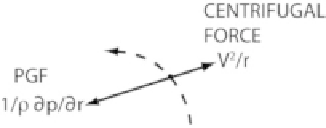Geoscience Reference
In-Depth Information
Figure 6.42. Forces in the inertial layer, within the boundary layer. The path of an air parcel is
indicated by the dashed streamline. The pressure gradient force (PGF) acts radially inward and
is the same as it is above the boundary layer. The centrifugal force is reduced by friction from
what it is above the boundary layer so that there is a net force (the forces are not balanced)
acting radially inward.
or circulation C
¼
2
r
v ¼
2
G
, as a ''potential vortex''. It is assumed that this
angular momentum is produced by the parent storm (baroclinically or from en-
vironmental vorticity or via frictional generation). It is the pressure gradient force
associated with this vortex that drives the flow in the boundary layer below. For
simplicity, we consider a vortex in which the radial pressure gradient force is inde-
pendent of height. This assumption is probably pretty good at low levels, but not
aloft, where the intensity of the vortex that drives boundary-layer flow decreases
with height above some altitude.
It is assumed that the azimuthal wind speed in the boundary layer is less than
it is above the boundary layer owing to surface drag, and that the radial pressure
gradient force in the boundary layer is the same as it is at the top of the boundary
layer, as just noted. As a result of the departure from cyclostrophic balance near
the ground, there is radial inflow (
Figure 6.42
)
. Such conditions have been
famously illustrated through the tempest-in-a-teacup analogue: stir a cup of tea
into a vortex and the tea leaves will quickly collect at the center of the bottom of
the cup as a result of frictionally induced convergence.
In the section of the boundary layer closest to the surface (i.e., the ''friction
layer'' for steady-state, axisymmetric flow), the radial equation of motion from
(6.9) is—based on solutions to the equations of motion with a no-slip lower-
boundary condition and by laser velocitometer measurements in the Purdue
vortex simulator—given approximately by
p
0
2
u
z
2
0
¼
0
@
=@
r
þ@
=@
ð
6
:
17
Þ
The pressure gradient force acts radially inward (
<
0) and the friction force acts
radially outward (
0). In other words, air is accelerated radially inward, but as it
rubs against the ground it is retarded, so that it experiences a force that acts
radially outward: there is a turbulent transport of zero radial momentum upward
and non-zero radial momentum downward, so that radially inward-flowing air is
slowed down (i.e., there is radial acceleration outward). The two forces just about
cancel each other (
Figure 6.43
). Horizontal turbulent transports of momentum are
much smaller than vertical transports. Equation (6.17) may be rewritten without
>

Search WWH ::

Custom Search